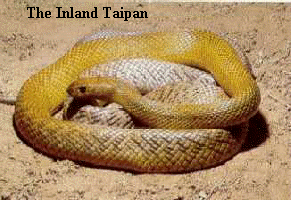


The astonishing evolutionary rate of man and the resulting intelligence we have gained places us, as our own unique species, at the head of the food chain. Something that is rarely threatened. Our vulnerability is so evidently exposed, however, when we disturb the habitat of certain deadly animals. Fatalities are rare, but at these times we observe the awesome power of nature ever so optimally.
This site, therefore, focuses on some of the most deadly and dangerous species of animal found on earth, with special emphasis placed on the pharmacology and chemistry of the toxins they use to envenom their prey.
The venom functions not only to stun the prey but also to aid in the digestion of victim once it has been eaten. An important point is that the venom of one animal is not purely one toxin, infact they are a complex set of proteins and toxins. The word toxin is used loosely in this context to include any of the toxins expressed in the list below!
The information on this page provides a detailed insight into the pharmacology of a general range of neurotoxins found in animal venoms. For specific species follow the case studies or some of the links contained in the whole site. There are also some interesting facts to be found, which will certainly make the mind boggle if only for a minute. Alternatively, try the quiz, that's if you think you've got what it takes to be the next Steve Irwin.
The toxins found in animals are divided into two classes: venoms and poisons. Venoms are essentially produced by a gland in the animal and must by delivered by special apparatus such as fangs (spiders, snakes), stings (bees, wasps), spines (fish), or by "harpoon" (cone shells) amongst other ways. The venom is therefore consciously used by the animal to hunt prey or defend themselves. Poisons, on the other hand, are principally methods of defense. Delivery occurs by ingestion of a part of the animal by a predator. In some cases the poison is emitted, or even squirted out, by simply touching the animal.
The components of these venoms/poisons are very complex. In a few cases, little is known about what the principal compounds are or how they act. A typical venom could contain any of the following:
Neurotoxins - cause paralysis or interfere with the central nervous system.
Haemotoxins - these affect the blood, particularly clotting abilities.
Myotoxins - cause damage to muscle.
Haemorrhagins - damage blood vessels resulting in bleeding.
Haemolysins - cause damage to red blood cells.
Cardiotoxins - directly affect the heart.
Nephrotoxins - directly affect the kidneys.
Necrotoxins - cause the death of tissue.
Other minor toxins
Neurotoxins have been found to be most responsible for the life threatening effects that these toxins exhibit, and so are the only toxin discussed here in detail.
Neurotoxins are a group of toxins that particularly affect the neuromuscular junction causing paralysis of prey. They are by far the most active constituent of any animal venom or poison but often have quite different modes of action and target sites.
The neuromuscular junction (NMJ) is responsible for all voluntary and respiratory movements of skeletal muscle. Signals are transmitted through the nervous system along neurons that are bridged by these junctions. A signal results in an action potential at the terminal axon by activating certain ion channels, this initiates the release of acetylcholine, a neurotransmitter, which crosses the extracellular space from vesicles where it was stored to special acetylcholine receptor proteins on the muscle end plate. When there is sufficient binding to the end plate an action potential causes significant changes to specific membrane channels and the muscle cell contracts. The acetylcholine that was released is then metabolised by cholinesterases in the extracellular space and is recycled back to the terminal axon for further release.
Neurotoxins function by affecting the outlined process, whether it is presynaptic or postsynaptic in action only a small change is needed to create a dramatic affect.
Presynaptic neurotoxins
These affect the mechanisms associated with the terminal axon, inhibiting neurotransmission. This can come in the form of damage to the terminal axon, disruption of synaptic vesicles or cessation of acetylcholine release, all effectively resulting in neuromuscular blockade, i.e. flaccid paralysis. The effects are not instantaneous and the neurotoxin must firstly reach the NMJ before it can damage the presynaptic membrane. It then exerts its toxic effects.
Initially it can cause the release of acetylcholine, with severe twitching observed in some cases, before it goes on to destroy the acetylcholine vesicles and thereby prevent acetylcholine release. This process has been shown to take approximately one hour experimentally and so it may take a while for the real effects of the neurotoxin to become apparent. Infact, it is unlikely for presynaptic paralysis to occur in less than 1-2 hours post envenomation.
Since presynaptic neurotoxins cause damage to the terminal axon, they respond poorly to therapy by antivenom. It is therefore imperative that the early signs of paralysis are recognised for there to be successful treatment using antivenom. If flaccid paralysis is well established then it can rarely be reversed. For example:
| Species | Neurotoxin |
| Kraits | ß-Bungarotoxin |
| Australian elapids | Notexin, Taipoxin, Textilotoxin. |
| Vipers | Crotoxin |
The following is a schematic depiction of the process of synaptic transmission and it also indicates where these toxins act:

Image from: http://www.toxinology.com
Postsynaptic neurotoxins
These are much more common than presynaptic neurotoxins and, although they are less potent, act more rapidly. The main method of action is to bind to the acetylcholine receptor proteins on the muscle end plate causing blockade. Therefore, any acetylcholine released from the vesicles is prevented from passing on the signal and instead is simply metabolised by the present cholinesterases in the extracellular space. The result is, of course, flaccid paralysis.
They are faster acting than presynaptic toxins because they can act as soon as they reach the NMJ. However, paralysis is rarely seen to take a great effect less than one hour post bite.
The most important factor is the accessibility of the venom, as the toxins remain exposed on the surface of the end plate in the extracellular space they can easily be knocked off by antivenom therapy. Alternatively, extra release of acetylcholine may be sufficient to overwhelm the toxin.
The structure of these toxins can be described as moderately sized and uniform in shape. They typically exhibit a complex folded structure which results in a "three finger" configuration, with the active site being the "middle finger". From here they can be further divided into short and long subgroups. The short toxins are classically 60-62 amino acids long cross linked by 4 disulphide bonds. The long toxins contain 70-74 amino acids and are cross linked by 5 disulphide bonds. These disulphide bonds are known to be the principal components of the toxin that are responsible for its relative toxicity. Both bind with high affinity to the nicotinic cholinergic receptor.
Dendrotoxins
This is a another subgroup of neurotoxins that are essentially presynaptic in function but act in a different way to the toxins outlined above. They block potassium channels on the terminal axon and result in substantial release of acetylcholine, after initial stimulation there is neuromuscular blockade. They are basic single chain polypeptides with 56-60 amino acids cross linked by 3 disulphide bridges.
Other neurotoxins
There are other neurotoxins but these are not always confined to act on the NMJ, instead some act on the autonomic nervous system rather than the nervous system, e.g. Kappa-toxins from snake venoms.